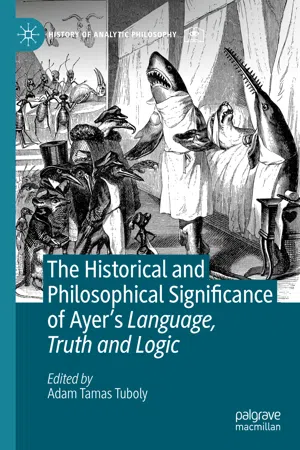
The Historical and Philosophical Significance of Ayer's Language, Truth and Logic
- English
- ePUB (mobile friendly)
- Available on iOS & Android
The Historical and Philosophical Significance of Ayer's Language, Truth and Logic
About this book
This edited collection provides the first comprehensive volume on A. J. Ayer's 1936 masterpiece, Language, Truth and Logic. With eleven original chapters the volume reconsiders the historical and philosophical significance of Ayer's work, examining its place in the history of analytic philosophy and its subsequent legacy. Making use of pioneering research in logical empiricism, the contributors explore a wide variety of topics, from ethics, values and religion, to truth, epistemology and philosophy of language. Among the questions discussed are: How did Ayer preserve or distort the views and conceptions of logical empiricists? How are Ayer's arguments different from the ones he aimed at reconstructing? And which aspects of the book were responsible for its immense impact?
The volume expertly places Language, Truth and Logic in the intellectual and socio-cultural history of twentieth-century philosophical thought, providing both introductory and contextual chapters, as well as specific explorations of a variety of topics covering the main themes of the book. Providing important insights of both historical and contemporary significance, this collection is an essential resource for scholars interested in the legacy of the Vienna Circle and its effect on ethics and philosophy of mind.
Frequently asked questions
- Essential is ideal for learners and professionals who enjoy exploring a wide range of subjects. Access the Essential Library with 800,000+ trusted titles and best-sellers across business, personal growth, and the humanities. Includes unlimited reading time and Standard Read Aloud voice.
- Complete: Perfect for advanced learners and researchers needing full, unrestricted access. Unlock 1.4M+ books across hundreds of subjects, including academic and specialized titles. The Complete Plan also includes advanced features like Premium Read Aloud and Research Assistant.
Please note we cannot support devices running on iOS 13 and Android 7 or earlier. Learn more about using the app.
Information
1. Introduction: From Spying to Canonizing—Ayer and His Language, Truth and Logic
Table of contents
- Cover
- Front Matter
- 1. Introduction: From Spying to Canonizing—Ayer and His Language, Truth and Logic
- Part I. The Book and Its Context
- Part II. Philosophy of Language in LTL
- Part III. Philosophy of Mind and Psychology
- Part IV. Epistemology and Truth
- Part V. Ethics and Values
- Back Matter